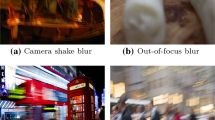Abstract
Super-resolution problem is posed as an inverse deconvolution problem. Fast non-iterative super-resolution algorithm based on this approach is suggested. Different super-resolution problem statements for the cases of exactly and inexactly known transform operator were considered.
Similar content being viewed by others
References
S. Borman and R. L. Stevenson, “Super-Resolution from Image Sequences—A Review,” Midwest Symposium on Circuits and Systems, pp. 374–378 (1998).
A. S. Krylov, A. V. Nasonov, and D. V. Sorokin, “Face Image Super-Resolution from Video Data with Non-Uniform Illumination,” in Proceedings of Int. Conf. Graphicon, 2008, pp. 150–155.
S. Farsiu, D. Robinson, M. Elad, and P. Milanfar, “Fast and Robust Multi-Frame Super-Resolution,” IEEE Trans. On Image Processing 13(10), 1327–1344 (2004).
Sung Won Park and Marios Savvides, “Breaking the Limitation of Manifold Analysis for Super-Resolution of Facial Images,” IEEE Int. Conf. on Acoustics, Speech and Signal Processing 1, 573–576 (2007).
Ha V. Le and Guna Seetharaman, “A Super-Resolution Imaging Method Based on Dense Subpixel-Accurate Motion Fields,” in Proceedings of the Third International Workshop on Digital and Computational Video, 2002, pp. 35–42.
B. D. Lucas and T. Kanade, “An Iterative Image Registration Technique with an Application to Stereo Vision,” in Proceedings of Imaging Understanding Workshop, 1981, pp. 121–130.
A. Bruhn, J. Weickert, and C. Shnorr, “Lucas/Kanade Meets Horn/Schunck: Combining Local and Global Optic Flow Methods,” International Journal of Computer Vision 61(3), 211–231 (2005).
J. Weickert and C. Shnorr, “Variational Optic Flow Computation with a Spatio-Temporal Smoothness Constraint,” J. Math. Im. and Vis. 14, 245–255 (2001).
T. Brox, A. Bruhn, N. Papenberg, and J. Weickert, “High Accuracy Optical Flow Estimation Based on a Theory for Warping,” in Proceedings 8th European Conf. on Computer Vision, 2004, Vol. 4, pp. 25–36.
A. N. Tikhonov and V. Y. Arsenin, Solutions of Ill Posed Problems (WH Winston, Washington DC, 1977).
A. S. Lukin, A. S. Krylov, and A. V. Nasonov, “Image Interpolation by Super-Resolution,” in Proceedings of Int. Conf. Graphicon, 2006, pp. 239–242.
Author information
Authors and Affiliations
Corresponding author
Additional information
The article is published in the original.
Andrey S. Krylov (born 1956), graduated from the Faculty of Computational Mathematics and Cybernetics, Lomonosov Moscow State University (MSU). Received the degree of PhD in 1983. Currently an associate professor and head of the Laboratory of Mathematical Methods of Image Processing at the Faculty of Computational Mathematics and Cybernetics, MSU. His main research interests lie in mathematical methods of multimedia data processing.
Andrey V. Nasonov (born 1985), graduated from the Faculty of Computational Mathematics and Cybernetics, Lomonosov Moscow State University (MSU). Currently a member of a scientific staff of the Laboratory of Mathematical Methods of Image Processing at the Faculty of Computational Mathematics and Cybernetics, MSU. His main research interests lie in variational methods of image processing, inverse and ill-posed problems.
Oleg S. Ushmaev (born 1981), graduated from the Lomonosov Moscow State University in 2002. He received the advanced degree in computer science from the Russian Academy of Sciences, Institute for Informatics Problems, in 2004 with a thesis on multimodal biometrics. Since then, he has worked as member of the Institute research stuff. His research interests in the area of pattern recognition and image analysis include biometrics, fast image processing and statistic pattern recognition.
Rights and permissions
About this article
Cite this article
Krylov, A.S., Nasonov, A.S. & Ushmaev, O.S. Video super-resolution with fast deconvolution. Pattern Recognit. Image Anal. 19, 497–500 (2009). https://doi.org/10.1134/S105466180903016X
Received:
Published:
Issue Date:
DOI: https://doi.org/10.1134/S105466180903016X




